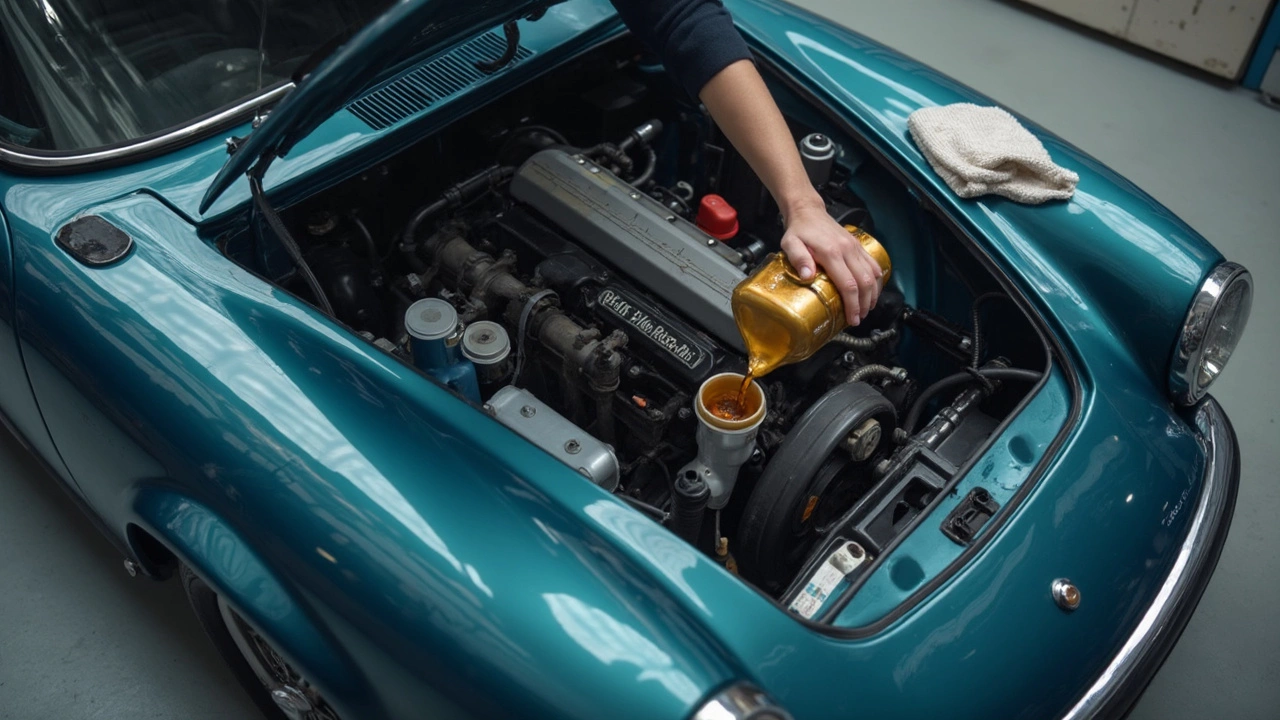Ever popped your hood and wondered, how much oil do I actually pour in when it's running low? A little too much or too little, and your engine could end up making some real unhappy noises—or worse, leave you by the side of the road.
Before you even think about topping off, grab a paper towel and check that dipstick. The lines marked "MIN" and "MAX" aren't just for show. If your oil is below or right at "MIN," you don't want to just wing it by dumping in a whole quart. Most engines hold about a quart between those two marks, but there's no one-size-fits-all answer.
Car manuals hide the real answers here. On most rides, adding half a quart will bump your level from the bottom line closer to the middle. Still low? Add another half-quart, but always give the oil a minute to settle, and check again. Overfilling can mess with gaskets and sensors. When in doubt, put in less, check, and repeat—slowly. Your engine will thank you.
- How to Check Your Oil Level Like a Pro
- Figuring Out How Much Oil Your Engine Needs
- Adding Oil: Safe Steps and Easy Mistakes
- Tips for Preventing Low Oil in the Future
How to Check Your Oil Level Like a Pro
Knowing how to check your engine oil the right way is one of the easiest car skills you can pick up, and it could save you thousands in engine repairs later. You'd be surprised how many folks get it wrong just by rushing.
Oil moves around all over your engine, so you want to check the level when things are calm. That means your car should be parked on a flat surface and the engine should be cold or at least shut off for 10 minutes. This lets the oil drain back into the pan for the most accurate reading.
- Pop the hood (the release is usually under the steering wheel or the glove box).
- Locate the oil dipstick—it often has a yellow or orange handle. If you can’t see it, your manual will point you in the right direction.
- Pull out the dipstick. Wipe the end clean with a paper towel or rag—old oil can make it hard to read.
- Stick the dipstick back into the tube all the way, then pull it out again. Now, check where the oil lands between the "MIN" and "MAX" (some dipsticks use dots or cross-hatched areas).
- If the oil is below "MIN" or looks barely there, it's time to add. But don’t go over "MAX." That can screw up seals and sensors.
Why wait until the engine's cool? Hot oil is thinner and moves up the sides, making it easy to misread. Quick tip—oil should look amber or dark brown, but shouldn’t be gritty or milky. If it is, you might need more than a top-up.
Exact dipstick markings vary, but most cars hold about a quart of oil between "MIN" and "MAX." Here’s a quick reference for common oil capacities in modern cars:
| Car Type | Typical Capacity Between Marks |
|---|---|
| Small car (4-cyl) | 0.8 - 1 quart (approx. 0.95 liters) |
| Midsize sedan (6-cyl) | 1 - 1.2 quarts (1.1 liters) |
| Pickup/SUV (8-cyl) | 1.2 - 1.5 quarts (1.4 liters) |
Watching your oil level every other fill-up is a solid habit, especially if your car has racked up some miles. Caught early, a small oil drop isn’t a big deal, but letting it get too low can destroy your engine faster than you’d think.
Figuring Out How Much Oil Your Engine Needs
Each car has its own oil appetite. You don’t want to just eyeball it and hope for the best. The safest way to know for sure? Look in your owner’s manual—that little book chilling in your glove box knows your engine inside out. Don’t have it? Most automakers list engine oil capacities online, and there are even stickers under some hoods showing the exact amount.
For most everyday cars, the gap between the "MIN" and "MAX" lines on your dipstick is about one quart (roughly 0.95 liters). But that range is tighter on some smaller engines—sometimes about half a quart. If the oil mark is sitting below "MIN," top up with half a quart first, wait about two minutes, and then check again. Still not at "MAX"? Add oil in quarter-quart steps. Never rush it, and never fill above "MAX." Too much oil is just as risky as too little, and can cause foaming, leaks, and damage to seals.
- If your dipstick is bone dry or you don’t see any oil line at all, don’t panic, but take it slow. Add one quart and recheck. If you still don’t see oil, you may need to add more, but go in small steps and watch for leaks.
- Always use the oil type recommended for your engine. The wrong oil weight can mess with pressure and protection.
- If you’re low on oil often, your engine might be burning or leaking it. That’s a sign to visit a mechanic soon.
Here’s a cheat sheet for how much oil most engines usually take from empty (for a regular oil change):
| Engine Size | Average Oil Capacity |
|---|---|
| 4-Cylinder | 4-5 quarts |
| 6-Cylinder | 5-6 quarts |
| 8-Cylinder | 6-8 quarts |
But if you’re just topping off because you’re low, remember to add oil in small amounts, check the level often, and keep your engine oil right in the sweet spot every time.

Adding Oil: Safe Steps and Easy Mistakes
If your engine oil shows low on the dipstick, adding just the right amount can save your engine from trouble. Here’s a clear way to handle top-ups without overdoing it.
Start with the basics. Make sure the car is on level ground and the engine is off for at least 5–10 minutes—this helps oil settle back into the pan, giving an accurate reading. Grab the correct oil weight for your car, usually listed on the oil cap or your owner’s manual (think 5W-30 or 0W-20 for most cars). Don’t grab the wrong stuff—using the wrong viscosity is a common and costly mistake.
- Pop the hood and locate the oil filler cap—it probably says “OIL” or shows an oil can symbol.
- Wipe the area around it with a rag to prevent junk from falling in.
- Remove the cap and use a funnel to avoid messy spills.
- Pour in half a quart if you’re at or just below "MIN" on the dipstick.
- Wait a minute for the oil to reach the pan.
- Check the dipstick. Still too low? Add another half-quart.
- Repeat as needed, but don’t cross the "MAX" line—more isn’t better here.
Biggest error? Overfilling. When oil is too high, it can foam up as the crankshaft splashes through it, leading to poor lubrication and possible engine damage. It’s a hassle to drain out excess—sometimes the only fix is removing oil with a suction pump or drain plug (not fun on the roadside).
Stuck without a funnel? In a pinch, roll up some clean paper or cut a water bottle to make one. Better than pouring straight from the bottle and risking an oily mess over your belts.
Here’s a quick reference for average oil amounts between dipstick marks for common car engines:
| Engine Type | Dipstick MIN-MAX Range | Approximate Oil Volume (Quarts) |
|---|---|---|
| 4-cylinder | MIN to MAX | ~1.0 |
| V6 | MIN to MAX | ~1.2 |
| V8 | MIN to MAX | ~1.5 |
Bottom line: take your time, check as you go, and always use the right oil. Adding a little, waiting, then checking the dipstick is safer (and cheaper) than going overboard.
Tips for Preventing Low Oil in the Future
Dealing with a low oil situation once is enough to make you want to avoid it forever. Good news: with a few simple habits, you can keep your engine oil right where it should be, no constant topping off needed.
- Check Your Oil Regularly: Make it part of your routine—every time you get gas or at least once a month. Waiting for the dashboard warning light isn’t a smart move, since oil can get dangerously low before that light even thinks about coming on.
- Follow Your Manual’s Oil Change Schedule: Most modern cars can go 5,000 to 7,500 miles between oil changes, but if you drive in dusty places or do lots of stop-and-go, you might need to change it sooner.
- Watch for Leaks: Spot oil stains on your driveway? Don’t ignore them. Even a small leak can drain your oil faster than you’d think. Have a mechanic check for loose drain plugs, old gaskets, or worn seals.
- Use the Right Oil Type: Using the wrong viscosity or cheap oil can cause extra burn-off, especially in older engines. Stick to what’s listed in your manual for best results.
Seeing low oil often? That might signal a bigger issue, like a worn-out engine or a leak you haven’t spotted yet. Cars with more than 100,000 miles are especially prone to using more oil between changes.
| Car Age | Average Oil Consumption Between Changes | What’s Normal? |
|---|---|---|
| New (<50k miles) | <1/2 quart per 5,000 miles | (Modern engines lose very little) |
| Midlife (50k–100k miles) | 1/2–1 quart per 5,000 miles | (Keep an eye on drops) |
| High Mileage (>100k miles) | Up to 1 quart per 3,000 miles | (Especially in older rides) |
Tired of surprise maintenance bills? Ask for a quick check of your PCV valve during regular services—when this little part clogs up, it can boost oil consumption a lot.
Keep a spare quart of your oil in your trunk, just in case. There’s no downside to being ready, and you’ll never be caught off guard if you need a quick top-off down the road.






